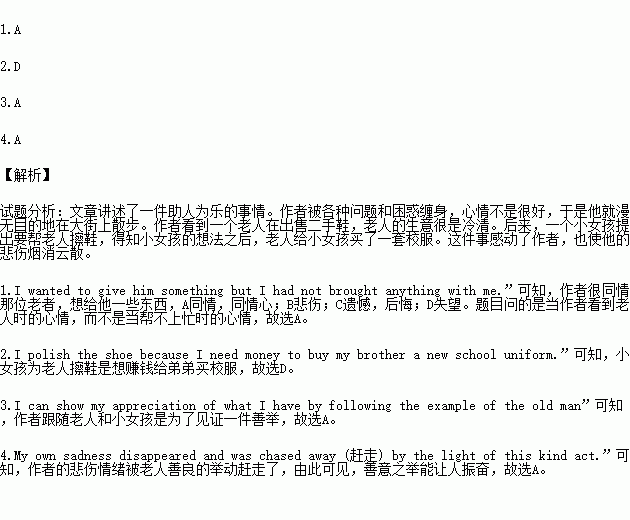题目内容
Today, I felt terrible. My head was full of problems, burdens and confusion. I decided to take a walk even though I didn't know where I would go.
The most extraordinary thing happened when I was on this walk.
I saw an old man sitting on a chair. He was a seller of second-hand shoes. I thought he looked at least seventy years old. He seemed so tired and nobody was buying his shoes. I wanted to give him something but I had not brought anything with me.
Then, a little girl came toward him. I heard the child say, “Grandfather, may I polish your shoes?” That old man took pity on her and he gave her a shoe to polish.
The girl said, “I polish the shoe because I need money to buy my brother a new school uniform.”
I heard this and tears came to my eyes. The old man answered, “Oh, little girl. Just stop doing this. Come with me and I will buy you a school uniform.” Then they walked to a market and I followed them behind. There he bought her a school uniform.
The girl said, “Thank you so much for doing this. May God bless you.” Then she left, leaving the old man smiling.
He walked away from the market, but I stopped him. I whispered in his ear, “You are a hero! Thank you for your kindness!” As I walked away, I glanced back and I could see him still smiling.
My own sadness disappeared and was chased away (赶走) by the light of this kind act. I began realizing that I have a lot to be thankful for. I hope, some day, I can show my appreciation of what I have by following the example of the old man who only had a little, but shared it beautifully with someone who had nothing.
1.When seeing the old shoe seller, how did the author feel?
A. Sympathy. B. Sorrow.
C. Regret. D. Disappointment.
2.Why did the girl offer to polish shoes for the old man?
A. She took pity on him.
B. She wanted to take care of him.
C. She meant to be friendly to him.
D. She expected to get help from him.
3.Why did the author follow the old man and the girl?
A. To witness a kind act.
B. To talk to the old man.
C. To know the old man.
D. To know where the market was.
4.By sharing the story, the author wants to convey a message that .
A. a kind act can cheer us up
B. the old man set us an example
C. some poor people need our help
D. we should stop pitying the old

